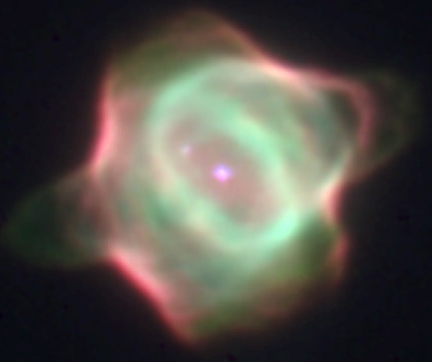
|
Explanation: This Hubble Space Telescope picture shows Hen-1357, the youngest known planetary nebula. Graceful, gentle curves and symmetry suggest its popular name - The Stingray Nebula. Observations in the 1970s detected no nebular material, but this image from March 1996 clearly shows the Stingray's emerging bubbles and rings of shocked and ionized gas. The gas is energized by the hot central star as it nears the end of its life, evolving toward a final white dwarf phase. The image also shows a companion star (at about 10 o'clock) within the nebula. Astronomers suspect that such companions account for the complex shapes and rings of this and many other planetary nebulae. This cosmic infant is about 130 times the size of our own solar system and growing. It is 18,000 light-years distant, in the southern constellation Ara.
|
January February March April May June July August September October November December |
| ||||||||||||||||||||||||||||||||||||||||||||||||
NASA Web Site Statements, Warnings, and Disclaimers
NASA Official: Jay Norris. Specific rights apply.
A service of: LHEA at NASA / GSFC
& Michigan Tech. U.
Based on Astronomy Picture
Of the Day
Publications with keywords: planetary nebula - white dwarf
Publications with words: planetary nebula - white dwarf
See also:
- APOD: 2025 August 31 B NGC 7027: The Pillow Planetary Nebula
- APOD: 2025 August 22 B A Tale of Two Nebulae
- APOD: 2025 August 5 B NGC 6072: A Complex Planetary Nebula from Webb
- APOD: 2025 July 29 B A Helix Nebula Deep Field
- APOD: 2025 July 13 B Planetary Nebula Mz3: The Ant Nebula
- APOD: 2025 June 9 B Between Scylla and Charybdis: A Double Cosmic Discovery
- APOD: 2025 May 14 B NGC 1360: The Robins Egg Nebula
